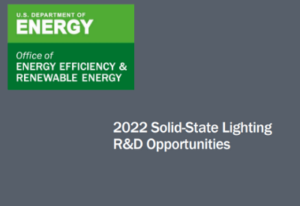DOE Publishes Solid-State Lighting R&D Opportunities
 The U.S. Department of Energy (DOE) Building Technologies Office (BTO), within the Office of Energy Efficiency and Renewable Energy (EERE), has published the 2022 edition of its report, Solid-State Lighting R&D Opportunities. The report presents the critical opportunities that exist to positively impact energy savings, greenhouse gas emissions, human well-being, and the economy through research and development of light-emitting diode (LED)-based solid-state lighting (SSL). The document summarizes stakeholder input from DOE-hosted roundtable meetings, workshops, a Request for Information, and other sources.
The U.S. Department of Energy (DOE) Building Technologies Office (BTO), within the Office of Energy Efficiency and Renewable Energy (EERE), has published the 2022 edition of its report, Solid-State Lighting R&D Opportunities. The report presents the critical opportunities that exist to positively impact energy savings, greenhouse gas emissions, human well-being, and the economy through research and development of light-emitting diode (LED)-based solid-state lighting (SSL). The document summarizes stakeholder input from DOE-hosted roundtable meetings, workshops, a Request for Information, and other sources.
SSL has become a predominant lighting technology that saves energy compared to almost all conventional lighting technologies and offers compelling new features that can increase energy savings and improve the function and value of lighting. Ongoing research in SSL technology supports multiple national priorities and has already resulted in a breadth of products that demonstrate considerable, measurable energy savings through improvements to light source efficiency — with a corresponding reduction in the emission of greenhouse gases through less electricity required to power lighting.
As a relatively new technology, SSL has required new manufacturing techniques and a new global supply chain; it has also created opportunities to foster domestic manufacturing capabilities for some parts of the lighting supply chain and for training the expanding workforce needed to support that production. SSL still requires knowledge of general lighting practices, but now also requires understanding of network communications, building systems, renewable energy supplies, new features enabled by LED technology, and even new application understanding such as human health impacts, horticultural optimization, and animal responses to light.
DOE data and analysis also reveal disparities for product availability and access to high-quality lighting – both in retail and public spaces – that have strong energy justice considerations. Addressing both energy justice and inclusion among lighting professionals is vital, not only for realizing the inherent potential of historically disadvantaged communities, but also to increase deployment of energy-efficient lighting and address key challenges to SSL adoption.
Unlocking the next wave of advancements in SSL will require further breakthroughs in fundamental, early-stage R&D across the SSL value chain, as well as better understanding barriers to deployment for technologies with the highest decarbonization potential. This report provides detail on these advancements and the R&D necessary to make breakthroughs.
Priority opportunity areas include:
- Lighting Platform Technology R&D to support scientific, technological, integration, and manufacturing understanding and advancements of the LED technology platform that enable energy savings and support occupant health and productivity. Topics include material and device science, down-converter technology, diffuse light source materials and devices, optical delivery and control, power and functional electronics, advanced lighting concepts, and manufacturing technologies.
- Lighting Science R&D to support research and understanding of fundamental lighting science and guide effective implementation of LED light source technology. Topics include lighting application efficiency (LAE) framework and human physiological impacts of light.
- Lighting Integration and Validation to support field research to transition new lighting technology and understanding to practice and quantify the benefits. Topics include translating lighting research findings to practice and connected lighting with integrated controls and grid-interactive capabilities.
To download this solid-state lighting report, click here























